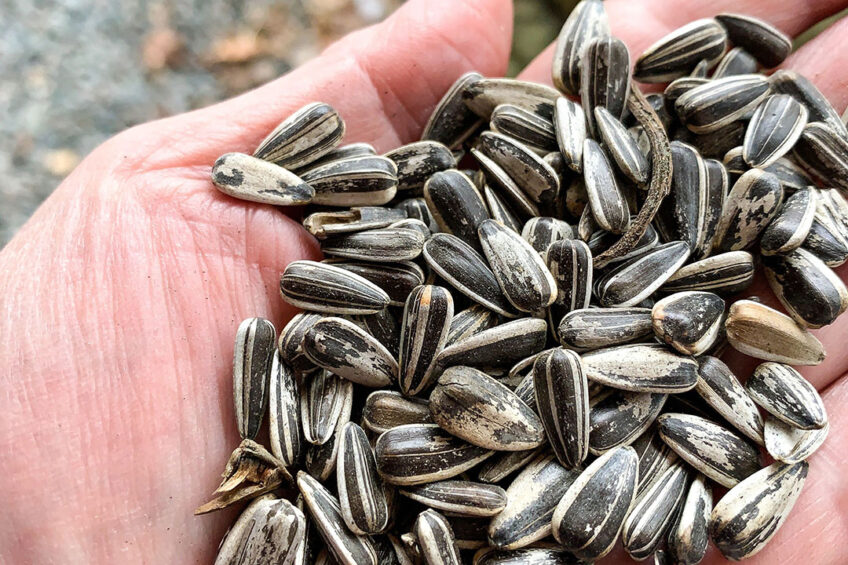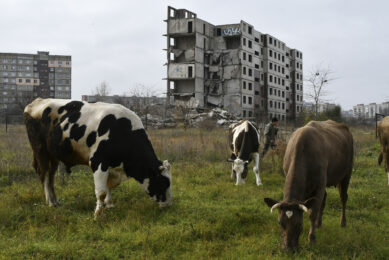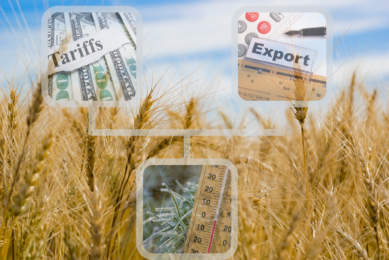End of grain deal – global grain markets nervous

There is no panic in the world grain market since the grain deal for export from Ukraine expired. And Russia’s bombing of ports and grain storage sites. But the market is nervous, resulting in rising prices.
The world grain market held its breath for a moment when it became clear in mid-July that the UN grain deal (see box) would not be extended. And all the more so when Russia subsequently bombed various places in the port city of Odessa. This was later followed by drone attacks on the grain stores in the Ukrainian border towns of Reni and Izmajil, which were severely damaged as a result. Attacks that continue, also this week. In addition, Russia has threaten to attack ships that sail to Ukraine.
As a result, world grain prices rose immediately, but not to the extent of February last year after the start of the Russian invasion of Ukraine. “I also don’t believe that the hectic pace of that time will return,” says director Jan Bakker, director of trading company De Vries & Westermann, Hoofddorp, the Netherlands. “In February last year, the Russian invasion was a complete surprise, which led to panic reactions. But we are now more used to the situation, however, it remains painful and worrying situation for the population of Ukraine,” says Bakker.
Peter van Dijk, senior policy adviser Netherlands Enterprise Agency, agrees with Bakker. “If you look at Ukraine’s share of global grain exports and the stocks of grain available, the panic response seems more emotionally motivated than factual.”
Jan Willem Baas, chairman of the Committee of Grain Traders, says that the suspension of the trade grain deal came as no surprise. “There was already some anticipation of this in the pricing.”
After the invasion of Russia February 24, 2022, grain prices skyrocketed. To fall afterwards, partly due to the UN grain deal of July 22, 2022. The expiry of the grain deal on July 17, 2023 led to higher prices, but lower than last spring.
The world population continues to increase and there will also be a year in which the grain harvests will be disappointing
World stock ample buffer
Let’s start with the facts that Van Dijk already pointed out (see table). In the closed 2021/2022 grain season, global wheat production was 780 million tons. Ukraine’s share was only 3% with 25.4 million tons. For corn and soybeans, that percentage is even lower. Van Dijk: “If you compare the annual wheat production of Ukraine (25.4 million tons) with the world stock (275 million tons), you see that the world stock is almost 11 times the annual production of Ukraine.” By which he means that there is sufficient buffer available worldwide, however, more than 52% is not freely tradable because it is stored in China.
In addition, according to Van Dijk, the available stock in the 8 largest exporting countries will decrease by about 20% in the 2023/24 season to the lowest level in 16 years. However, the influence of Ukraine on the world market for sunflower oil is statistically greater. With an annual production of 4.4 million tons, its share of the global production of 15.8 million tons is 28%.
Economic warfare
According to experts in ‘The Moscow Times’ (one of the few independent media outlets in Russia, co-founded by Dutch media entrepreneur Derk Sauer), the intention of the Russians is to put further pressure on Ukraine’s revenues and to profit from price increases themselves on the world grain market. The newspaper calls it economic warfare. The drone attack on the port of Reni on the Danube, which forms the border between Ukraine and Romania, was particularly devastating.
An influential Russian food & agri expert says in the Russian newspaper that this attack has more impact than the bombings in Odessa. Since last year, Ukraine has invested heavily in the grain terminals in Reni and nearby Izmajil. This makes it possible to transport grain by barge to the Black Sea via the border river Danube to be transferred to seagoing vessels in or before the Romanian port of Constanta. According to the expert in the Russian newspaper, both transfer points on the Danube are good for 2 million tons per month.
Search for alternatives
Jan Willem Baas points to the accelerated search for alternative methods of getting grain and other agricultural products out of Ukraine. According to him, trains with grain are still running daily destined for the Netherlands and Germany. But expanding will not be easy, he thinks, because the Dutch and German rail networks are already quite full. Another complicating factor is that the rail network in Ukraine does not connect to the Western rail network, which means that everything has to be transferred with all the associated costs. Export by road is not really an option, he says. “That’s just way too expensive.”
Eyes are therefore mainly focused on exports via Romania. The role of Romania is a sensitive one in Europe, since that country, together with Poland in particular, but also Hungary, Bulgaria and Slovakia, refuses to allow grain into their own country. This is because the grain from Ukraine flooded those countries, causing prices to fall sharply angering local farmers. Ultimately, a deal with the EU followed, after which the Eastern European countries were willing to export the grain and the farmers in the 5 countries were financially supported as the EU released € 100 million from the so-called crisis reserve.
The agreed transit in Poland, for example, is guaranteed by having the transport take place in sealed train wagons with stricter border controls, which makes the already expensive transport even more expensive.
‘Catastrophic for Ukrainian farmers’
All in all, the impact of the cancellation of the grain deal on global grain trade is not as great as last February. On the other hand, the impact is huge for farmers in Ukraine. Kees Huizinga, a Dutchman with a large arable farm in Ukraine and who makes weekly vlogs about it, calls the current situation ‘catastrophic for farmers in Ukraine.’ He cites a contract for 700 tons of barley as an example. The barley was supposed to be picked up by trucks last Wednesday to be transported to the border town of Izmajil. In order to be transferred to inland vessels, which sail via the Danube to the Black Sea to the Romanian port of Constanta. Where the barley would then be transhipped into seagoing ships. But the Russians have launched attacks on Izmajil again, calling it all off. The contract was already a financial loss, because of all the extra transport movements (converted $ 85 per ton) Huizinga only received $ 110 per ton of barley. “Of course we cannot continue farming in Ukraine for such a price,” said an exasperated Huizinga on the phone in the Netherlands, where he and his family are on a short holiday.
Huizinga explains that the price increases on the world market are now relatively better than expected due to good harvests in the US, Brazil and Russia. He also has record harvests himself, he says. More than 9 tons of winter barley per hectare, between 8 and 10 tons of winter wheat and 4.1 tons per hectare on 2 plots of rapeseed that have now been harvested. “These are truly unprecedented returns for us.” But he warns against the quick conclusion that the world can do without or with much less grain from Ukraine. “The world population continues to increase and there will also be a year in which the grain harvests will be disappointing. Without Ukraine, prices will shoot through the roof, that will not do you any good.”
According to Huizinga, the only real solution is “that Russia has to be kicked back into their cage.” “As long as that doesn’t happen, they will continue to hold the world hostage.”
Geopolitical power play
Grain from the Ukraine is therefore part of the current geopolitical power game. The Western world supports Ukraine on all sides. For example, the EU announced at the end of June that it would set up a ‘Ukraine facility’ to provide additional financial support to the country with a total of €50 billion in the form of grants and loans between 2024 and 2027. And the UN continues to make efforts, as much as possible, to mitigate the consequences for countries, African countries in particular, which are much more dependent on grain from Ukraine. Because of this and because of the good grain harvests worldwide, there is no panic on the global grain market, but the market remains nervous. Because of the speculative nature of a number of players in that market, new Russian attacks on the grain infrastructure in Ukraine could lead to price increases. There is no rational reason for this, but sentiment always remains a factor in pricing and that should not be underestimated.











